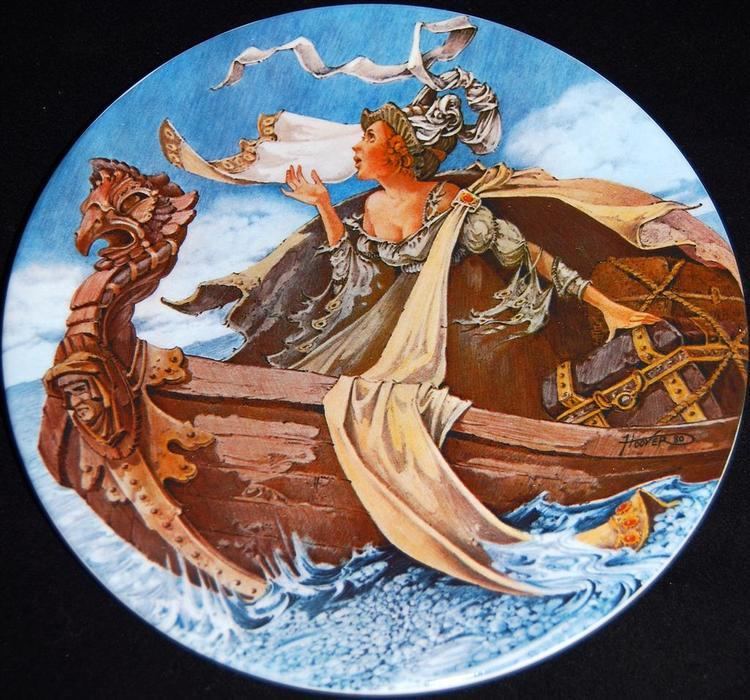Preceded by The Cook's Tale | ||
 | ||
Similar Geoffrey Chaucer books, The Canterbury Tales books, Other books | ||
The Man of Law's Tale is the fifth of the Canterbury Tales by Geoffrey Chaucer, written around 1387. John Gower's "Tale of Constance" in Confessio Amantis tells the same story and may have been a source for Chaucer. Nicholas Trivet's Les chronicles was a source for both authors.
Contents
The man of law s tale
Summary
Constance (Custance in Chaucer) is the daughter of the emperor in Rome. Syrian merchants report her great beauty to the Sultan. A marriage contract is negotiated by her father which requires the Sultan and his subjects to convert to Christianity.
The Sultan's mother, enraged that her son would turn his back on Islam, kills her son and the wedding party and has Constance set adrift on the sea. Her adventures and trials continue after she is shipwrecked on the Northumberland coast. The validity of her Christian faith is proved by two miracles. A blind man is healed by her companion Hermengyld. A wicked knight who wishes to seduce Constance murders Hermengyld and attempts to frame Constance using the bloody dagger. He perjures himself and is mysteriously struck dead. Northumberland is a nominally pagan country where the King, Alla (based on Chaucer's understanding of the historical Ælla of Deira) converted to Christianity after learning of the two miracles. Alla's evil mother intercepts and falsifies letters between the Alla and his constable, which results in Constance's being banished.
Constance is forced to go to sea again but runs aground in Spain. A would-be rapist (Thelous in Confessio Amantis) boards her ship but mysteriously falls overboard. She is found by a Senator of Rome. He is returning from a mission to Barberie (Syria) where he revenged the slaughter of Christians by the Sultan's mother. The Senator takes Constance (and her child) back to Italy to serve as a household servant. King Alla, still heartbroken over the loss of Constance, goes to Rome on a pilgrimage, where he is reunited with Constance. The couple return to Northumberland. Alla dies a year later, and the baby boy becomes the King.
The Man of Law (referred to here as 'A Sergeant of the Lawe') is a judicious and dignified man, or, at least, he seems so because of his wise words. He is a judge in the court of assizes (civil procedures), by letter of appointment from the king, and has many goods and robes. He can draw up a legal document, the narrator tells us, and no-one can find a flaw in his legal writings. The Man of Law rides in informal, silk-adorned clothes. GP
Saints' lives genre
The tale is meant as a morally uplifting story and is similar to hagiography, or stories of the saints' lives, which were common popular literature of the time. Custance, as her name suggests, is constant to her Christian religion despite the attacks and testing it receives from the pagans and heathens she meets on her travels.
Rhetoric
The Man of Law tells his story in a pompous over-blown style as if he is defending Custance in a court of law. He also uses several rhetorical figures such as “so as ye shal heere" and "of which I tolde", taken straight from the manuals of rhetoric of the day, to emphasise Custance's noble character—as well as the teller's lawyerly skills—and state her case.
John Gower
Although Chaucer receives some praise and also criticism from his own character with favourable mentions of The Book of the Duchess and The Legend of Good Women; in the Introduction to the Man of Law's Tale he seems to spare most of his opprobrium for John Gower. Two of the tales which he dislikes, Canace and Apollonius of Tyre, involve incest, as did the some versions of the story. Chaucer based this tale on the Nicholas Trivet story from his Chronicle. Gower though had recorded all these stories. Chaucer is, perhaps, with friendly banter, trying to goad his friend and fellow writer into a storytelling challenge.
But certeinly no word ne writeth heOf thilke wikke [wicked] ensample of Canacee,That loved hir owene brother synfully –Of swiche cursed stories I sey fy! –Or ellis of Tyro Appollonius,How that the cursed kyng AntiochusBirafte his doghter of hir maydenhede,That is so horrible a tale for to rede,Whan he hir threw upon the pavement.Sequence with other tales
The various manuscripts of the Tales differ in the sequence of the Tales. 35 manuscripts contain the Man of Law's epilogue, while 22 others (including the Ellesmere Manuscript) do not. In the epilogue, the host invites the Parson to speak next, but the Parson is interrupted before he can begin and a different speaker tells the next tale. In the various manuscripts, the interrupter is Summoner, the Squire, or the Shipman, but it is the Shipman whose character best matches the rude remarks (although the mention of his "joly body" sounds closer to something the Wife of Bath might say). What this probably shows is that Chaucer had not fixed his overall plan. There are also hints, with his claim he will talk in prose despite rhyming throughout, that the Man of Law originally told the Tale of Melibee before he was assigned Custance's tale late in the composition of the tales.
